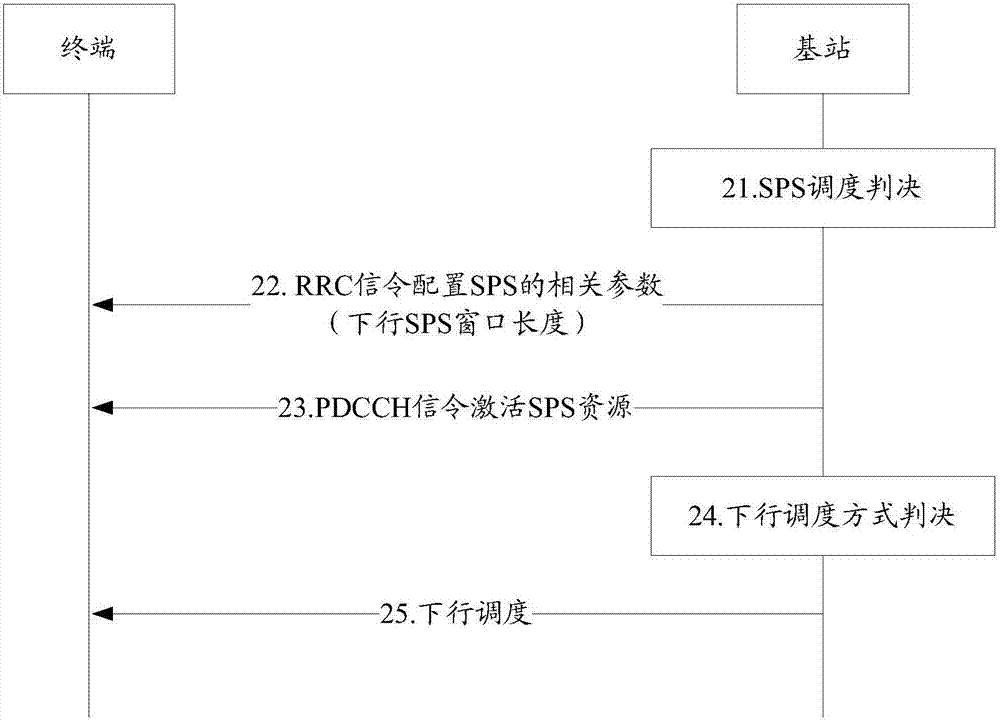Scheduling method and device, and equipment
A scheduling method and transmission direction technology, applied in the field of communication, can solve the problems of increasing service delay and inability to match SPS resources, and achieve the effect of reducing signaling overhead
- Summary
- Abstract
- Description
- Claims
- Application Information
AI Technical Summary
Problems solved by technology
Method used
Image
Examples
Embodiment 1
[0100] Embodiment 1: In this embodiment, RRC signaling is used to configure the SPS window corresponding to the downlink SPS. The specific process is as Figure 2A shown, including:
[0101] Step 21: SPS scheduling decision, details are as follows:
[0102] The base station determines to use the SPS for downlink transmission according to parameters such as Quality of Service (QoS for short) or service type corresponding to the downlink service of the terminal.
[0103] Step 22: RRC signaling configures relevant parameters of the downlink SPS, as follows:
[0104] The base station configures related parameters of downlink SPS for the terminal through RRC signaling, wherein parameter information of downlink SPS window length (referred to as semiPersistSchedWinowLength in this embodiment) is added to the RRC signaling. The content of the RRC signaling is shown in Table 1:
[0105] Table 1: Contents of RRC signaling for configuring downlink SPS
[0106]
[0107]
[0108...
Embodiment 2
[0115] Embodiment 2: In this embodiment, PDCCH signaling is used to configure the downlink SPS window corresponding to the downlink SPS, and the specific processing process is as follows image 3 shown, including:
[0116] Step 31: SPS scheduling decision, refer to the relevant description in Embodiment 1 for details.
[0117] Step 32: RRC signaling configures downlink SPS related parameters, as follows:
[0118] The base station configures relevant parameters of the downlink SPS for the terminal through RRC signaling, wherein the content of the RRC signaling is the same as that of the existing downlink SPS configuration RRC signaling.
[0119] Step 33: PDCCH signaling activates the downlink SPS resource, as follows:
[0120] The base station activates the downlink SPS resource through the PDCCH signaling, wherein the PDCCH signaling adds the parameter information of the downlink SPS window length (referred to as semiPersistSchedWinowLength in this embodiment). Take DCI for...
Embodiment 3
[0125] Embodiment 3: In this embodiment, RRC signaling is used to configure the uplink SPS window corresponding to the uplink SPS, and the specific processing process is as follows Figure 4 shown, including:
[0126] Step 41: SPS scheduling decision, details are as follows:
[0127] The base station determines to use the SPS for uplink transmission according to parameters such as QoS or service type corresponding to the uplink service of the terminal.
[0128] Step 42: RRC signaling configures the relevant parameters of the uplink SPS, as follows:
[0129] The base station configures related parameters of the uplink SPS to the terminal through RRC signaling, wherein parameter information of the uplink SPS window length (referred to as semiPersistSchedWinowLength in this embodiment) is added to the RRC signaling. The content of RRC signaling is shown in Table 3:
[0130] Table 3: Contents of RRC signaling for configuring downlink SPS
[0131]
[0132] Step 43: PDCCH sig...
PUM
 Login to View More
Login to View More Abstract
Description
Claims
Application Information
 Login to View More
Login to View More - R&D
- Intellectual Property
- Life Sciences
- Materials
- Tech Scout
- Unparalleled Data Quality
- Higher Quality Content
- 60% Fewer Hallucinations
Browse by: Latest US Patents, China's latest patents, Technical Efficacy Thesaurus, Application Domain, Technology Topic, Popular Technical Reports.
© 2025 PatSnap. All rights reserved.Legal|Privacy policy|Modern Slavery Act Transparency Statement|Sitemap|About US| Contact US: help@patsnap.com



